-
Chapter 2: EARTH
Introduction
The upper layer of the Earth’s crust is called lithosphere. It has 2 parts – upper part is granitic rocks and forms the continents. Its main constituent is Silica and Aluminum and is also called SiAl. It has a density of 2.7. The lower part is denser and is called SiMa [Silica, iron, magnesium]. As the SiAl is lighter than SiMa the continents are said to be floating on denser SiMa. The thickness of the crust is about 30 miles.
Below the crust is the Mantle which is 1800 miles thick. It is made up of dense layer very rich in olivine. The interior of mantle is the core which has radius of 2100 miles. It is called NiFe layer as it is made up of Nickel and Ferrous/iron. The inner part of the core is solid.
The Earth has three layers:
a. Outer layer: Continents [SiAl – Silica + Aluminum] are granite and oceans are basaltic
b. Mantle and oceanic crust: SiMa; mantle is Olivine. Highly fluidic
c. Inner layer: Core [NiFe – nickel + ferrous]. Outer core is liquid and inner core is solid.
Iron has highest composition in earth and oxygen has highest composition in Earth's crust. Continental crust is light and oceanic is heavy.
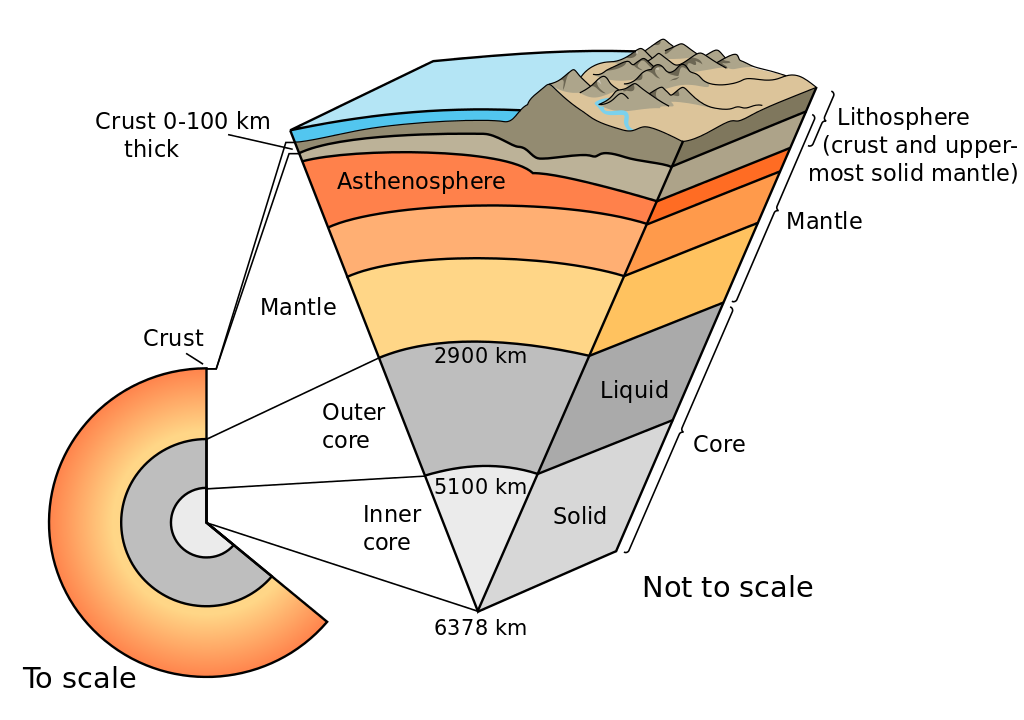
Fig 1: Rock layers
Rocks in the earth’s crust:
1. Igneous rocks:
a. Formed by solidification of magma or lava.
b. Don’t have strata or layers.
c. Don’t have fossils.
They are further divided into types based on mineral composition:
- Acid igneous rock: less dense and lighter
- Basic igneous rock: denser and darker
In terms of origin there are two main types of igneous rocks:
- Plutonic rocks: these are formed after the magma has cooled beneath the Earth’s surface. Because of slow cooling the crystals formed are large and easily recognized. E.g. granite
- Volcanic rocks: the molten rocks pour out of the surface as lava. This cools faster at the surface and crystals formed are small. E.g. basalt
Most igneous rocks are hard and resistant and so are mostly used for road making, gravestones and monuments.
2. Sedimentary rocks:
a. Formed when sediments compact under pressure lose fluid and become solid called lithification. They are non crystalline.
Types:
Mechanically formed sedimentary rocks: These rocks are made from accumulation of material from other rocks that is cemented together.
Organically formed sedimentary rock: these are formed from remains of marine life having shells like oysters or snails. As the fleshy part perishes the calcareous part fuses together. Carbonaceous origin sedimentary rock is formed when vegetative matter is compressed into carbon forms due to weight of overlying matter. Peat, lignite and coal are formed in this manner.
Chemically formed sedimentary rocks: these are formed from chemical precipitation from solutions. E.g. rock salt, gypsum
3. Metamorphic rocks:
a. Formed when agents like heat or pressure or both act on igneous or sedimentary rocks.
b. No fossils or strata. E.g.: granite -> gneiss, sandstone -> quartzite
Weathering of Rocks:
The work of weathering is of two kinds: Chemical or Physical.
- Chemical: The reactions caused by elements in water or air causes the rocks to decompose slowly.
- Chemical Solution
- Wet climates promote chemical weathering and dry climate promotes physical weathering.
- Mineral composition of the rock and the density of joints and cracks also affect weathering.
- Decomposition by oxidation or organic acids.
- Physical weathering:
- Repeated cycles of high and low temperatures
- Repeated wetting and drying.
- Biotic factors like plant roots
- Activities of men like mining
Rock cycle:
Igneous rocks under lithification become sedimentary / [metamorphic under heat] and further on heat or pressure become metamorphic. This again on melting becomes magma which turns to igneous rocks.
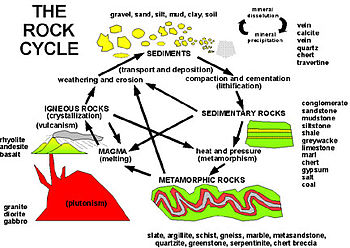
Fig 2: Rock cycle
Seismic
wave
studies: the waves are S waves [can travel through solids and
gases] and P waves [can travel through all mediums but speed is
fastest in solids and least in gases].
Formation of continents:
Theory 1: Continental drift theory
1. Alfred Wegener propounded it
2. It was based on matching coastlines, similarity in age of rocks, fossil evidence i.e. similar plant and animal fossil found on both sides of the continents and glacial evidence in tropical lands.
3. His theory was that the super continent – Pangaea broke up into continents 200 million years ago by drifting over the oceans.
4. However his theory doesn’t explain how the gravitational forces could have affected the movement of continents. He couldn’t explain the driving force for the drift. Also his model of crust doesn’t agree with modern version. The speed of drift suggested by him too was implausibly high.
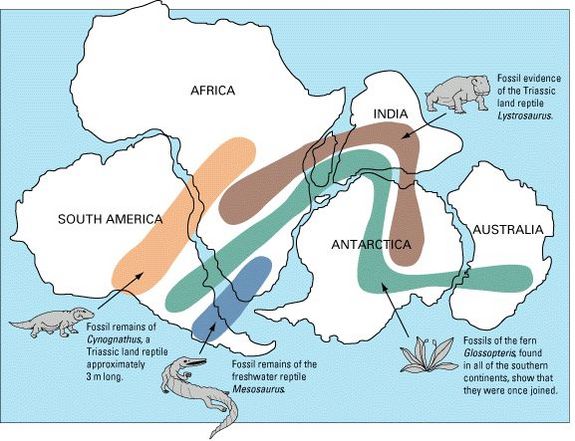
Fig 3: Continental drift
Theory 2: Convention current theory / sea floor spreading:
1. A convention cell which is like a conveyor belt moves under the crust and is responsible for drifting of the continents.
2. The sea floor has a lot of diversity: Mid ocean ridges, trenches, continental slopes, ocean floor. Some questions emerged as finding proved that oceanic crust was 200 million years old, age of crust increases away from mid ocean ridge and sea mounts deformed at trenches.
3. The sea floor spreads due to the convention current and magma comes out this forms new ocean crust and expansion of ocean crust.
4. It could also explain trenches in the ocean. The diverging oceanic crust was heavier than the continental crust. It was subdued under and it melted inside the mantle.
Mariana trench: – Pacific Ocean near Philippines.
Diamantine trench: – Indian Ocean near Australia.
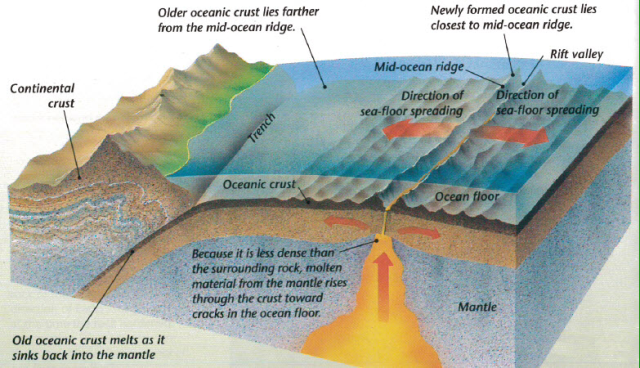
Theory 3: Plate tectonic theory
1. Some questions that remained unanswered were the formation of Fold Mountains, reasons for earthquakes and reasons for Volcanism on land.
2. The theory states that the crust isn’t continuous but broken into plates. The lithosphere floats over the Athenosphere.
3. There are entirely continental, entirely oceanic and mixed plates. Totally 6 major and 20 minor plates.
4. Plates interact due to earth’s rotation. These interactions are of types:
a. Divergent plate boundary: below oceans the divergence of plates causes mid ocean ridges. And below continents it causes rift valley and nascent sea.
b. Convergent plate boundary: ocean and ocean plate convergence causes island arcs like in the Indian ocean and Philippines archipelago; ocean continent plate convergence causes volcanic mountains like in Andes, rocky and atlas mountains and continent plate convergence causes fold mountains like Himalaya, alps and Ural.
c. Transverse boundary: when the two plates slip past each other it doesn’t have any mountain formation but causes seismic activity. E.g.: San Andréa’s fault in USA.
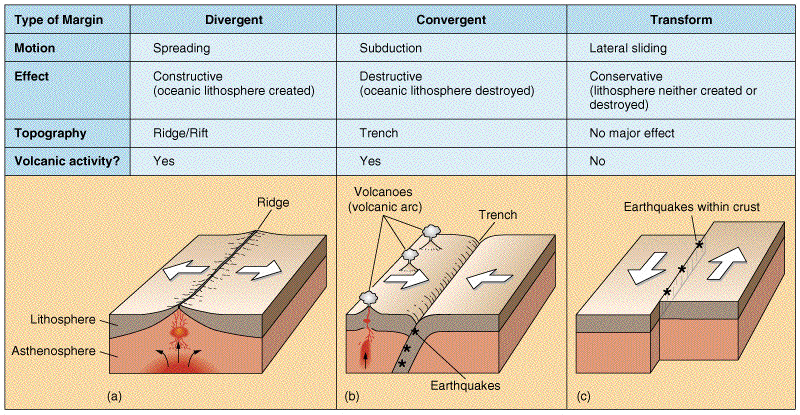 Fig 5: Plate movements
Fig 5: Plate movementsSolved Question Papers
Q.Which of the following phenomena might have influenced the evolution of organisms?
Continental drift
Glacial cycles
Select the correct answer using the code given below. (UPSC CSAT 2014)
1 only
2 only
Both 1 and 2
Neither 1 nor 2.
Ans . C
One of the most prominent example of the effect of continental drift on evolution of organisms, is the unique primates found in Australia and South America.
The final stages of evolution of Genus Homo occurs in the last 3 glacial cycles.
Chapter Review
Score more than 80% marks and move ahead else stay back and read again!